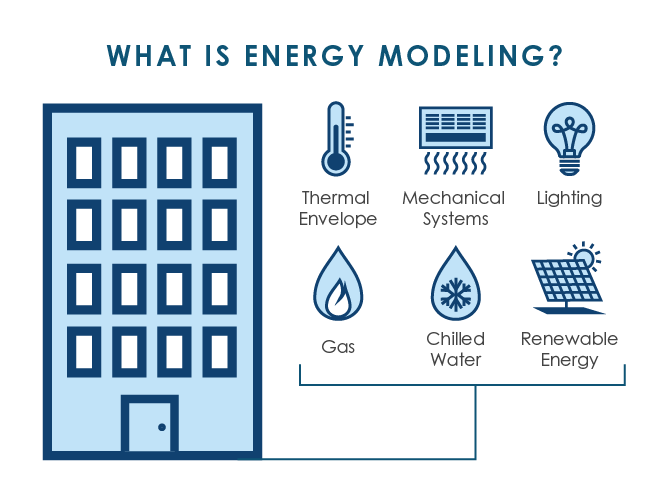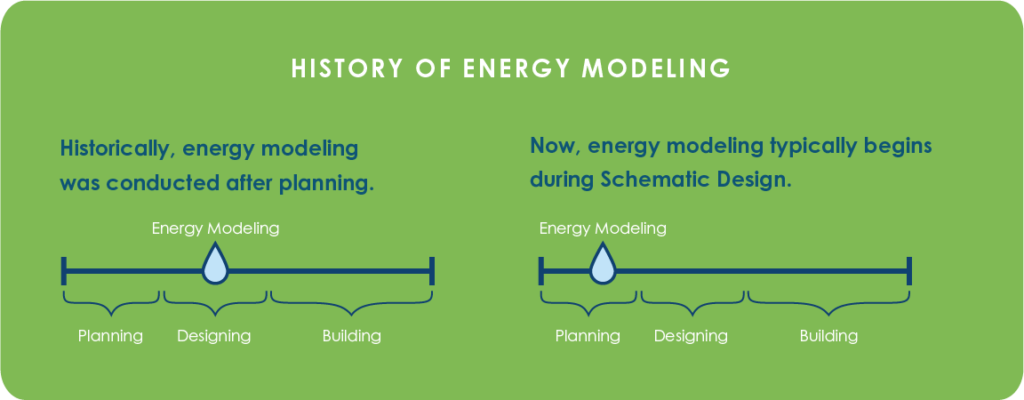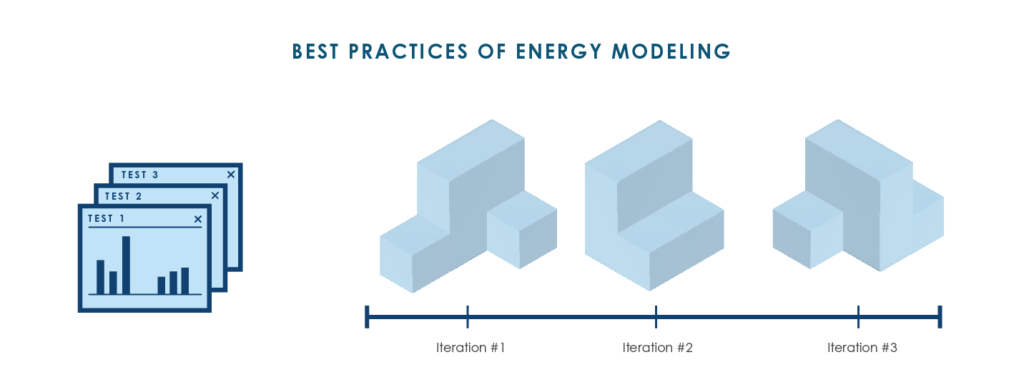Energy Modeling: Owners’ & Developers’ Guide

Today’s building energy codes are continually evolving, alongside sustainability and green building programs. Two critical components of both energy codes and green building programs are energy performance and verification. The results from energy modeling provide data-driven energy performance predictions, which can be used to attract tenants, avoid costly retrofits, and analyze how different systems or equipment could impact energy use. With building energy modeling, licensed sustainability experts calculate a project’s potential energy consumption to help Owners and Developers ensure compliance with energy codes, financing programs, and green building programs.
Energy Modeling
Energy modeling is the process of estimating a building’s expected energy consumption by taking the building thermal envelope, lighting, mechanical and other powered systems connected to it and simulating their operation in specialized computer software. This process can be as simple as a single system calculation or as in-depth as a simulation of a fully operational building. Energy modeling recreates as much of a building’s systems as desired, such as its thermal envelope, HVAC systems, lighting, hot water systems, and virtually analyzes its energy use.
Many Owners and Developers use building energy modeling services to help ensure compliance with energy codes, green building programs, and financing programs. Under both ASHRAE 90.1 and the 2015 edition of the IECC, energy modeling can be used to calculate a project’s potential energy consumption for energy code compliance as an alternative to prescriptive compliance methods. This allows for assessments of on-site renewable energy needs and trade-offs between different parts of a building that impact energy consumption, including the building envelope and MEP systems.
Energy modeling can also be used to find creative design alternatives, as the process helps Owners, Developers, and project partners identify more energy-efficient building layouts, systems and equipment. During the planning and design phases, energy modeling provides a holistic view of the impacts of different orientations, systems, etc. in order to make efficiency decisions proactively.
The results from building energy modeling can be used to provide an estimated ENERGY STAR (ES) Score, Statement of Energy Design Intent (SEDI), as well. That score can then be submitted to code officials to help fulfill mandatory disclosure requirements and document the likely building energy efficiency once the project is operational. Achieving a higher score on energy modeling results before a building opens typically leads to fewer or less costly retrofits over the course of the building’s life cycle. Green building programs, such as the National Green Building Standard (NGBS), LEED, and ENERGY STAR, require energy data disclosure. Financing programs, including those from the US Department of Housing and Urban Development (HUD), Fannie Mae, and Freddie Mac, also incentivize Owners and Developers who maintain compliance and continually meet their energy standard. Additionally, many states and local municipalities are encouraging building operators to report and benchmark building energy consumption as part of ESG measures and provide a basis for carbon emission reduction.
The Development of Energy Modeling

Historically, energy modeling was conducted after planning. Models would begin in the Design Documents phase after floor plans and equipment systems had already been selected, which left little time for modifications in building layout and system analysis. As a result, building energy modeling services didn’t have much impact in the design process and were generally used as a means to show compliance rather than used as a design tool. However, in response to the recent rise in sustainability regulations and requirements, energy modeling has become a primary method to help Owners and project partners ensure compliance for new and existing buildings.
Today, energy modeling typically begins during Schematic Design, providing architects with a more holistic picture of a building’s systems and operating conditions. Modeling earlier in the design process allows for faster optimization and greater insight into building performance. Before design drawings are complete, the results from energy models can be utilized to present options that improve building energy efficiency and avoid backtracking on a project’s plans to correct inefficiencies. Licensed sustainability experts, like those at Jordan & Skala Engineers, can use building energy modeling from beginning to end to help Architectural and MEP teams ensure that a project’s systems will work together efficiently. The results from the simulations, calculations, and analyses can inform design choices and help ensure code compliance and sustainability goals are met.
As energy simulations and modeling become increasingly common earlier in the project process, buildings can be designed to support efficiency goals and maximize efficiency opportunities from the outset. Even a building’s orientation affects its energy use; buildings with windows facing south in the northern hemisphere use more energy for heating and cooling than those with windows facing other directions. Early building energy modeling services allow for greater planning and optimization of window-to-wall ratios, which utilizes the greatest amount of sunlight to illuminate a room and optimize daylight strategies, while minimizing heat gain to regulate the space’s temperature.
HVAC systems are used for heating or cooling during different times of the year. Some systems are sized to meet peak loads, but they may not be able to maintain comfortable environments, due to system limitations and lack of humidity control during non-peak load periods, such as spring and fall periods. When building systems and equipment are at the limits of a project design’s capacity with no margin for error, there’s no safety net when outdoor temperatures are too hot or too cold, as humidity can be difficult to control.
Energy modeling can guide design choices to ensure that enough system capacity will be available during peak times. The modeling process is nuanced and differs from electrical and HVAC design, where maximum power and heat gains are considered standard to size equipment. Modeling utilizes specific technical knowledge to calculate, simulate, and design for maximum efficiency all year. With energy modeling, simulations can be conducted to demonstrate a building’s or system’s operation during different times of the year; project partners can use those results to update their designs for optimal efficiency year round.
Why Energy Modeling?

Energy models help set an expectation for a building’s energy use and associated costs, regardless of the building’s sector or how long it’s been in operation. The models are created by sustainability consultants to calculate a project’s estimated energy consumption compared to baseline buildings provided by ASHRAE 90.1 and the IECC using both industry and Owner-defined schedules of operations. These are used to show energy code compliance and improvements above green building rating system requirements. The ENERGY STAR Portfolio Manager, although not an energy modeling software, utilizes a scoring system which is a baseline of existing similar buildings and it is developed using actual consumption data of buildings in operation.
During the construction permitting process, energy code compliance is required to be shown. Energy modeling using either the IECC or ASHRAE 90.1 is a method to demonstrate a building is in compliance. Prescriptive options are also available, however energy modeling can provide greater flexibility. ENERGY STAR Scores, Statement of Energy Performance (SEP), indicates how a building performs in operation. ENERGY STAR Statement of Energy Design Intent (SEDI) provides insight into how a proposed design will compare against other buildings of the same use type. The ENERGY STAR Score is a significant factor when applying for green financing options or some green building certifications; therefore, energy simulations should begin early in the design phase.
A straightforward box model at the beginning of a project can render results according to a building’s intended shape, glazing, window distribution, or any other general elements. Box models are a type of energy model that can be calculated based on the physical properties of a project’s schematic design ideal systems and measurements.
As a project progresses, building energy modeling services can be conducted to analyze how various systems and equipment may impact energy usage. HVAC systems, single zone split or VRF systems for dwelling units, chilled water, or any other system can be simulated in specialized energy modeling software to compare energy cost for part of a life-cycle cost analysis. Building energy modeling can also be used for value engineering to find areas of improvement or trade-offs where costs can also be significantly decreased, such as continuous insulation on walls. In such an instance, energy models can steer project partners away from continuous insulation to more cost-effective options that may be as little as a fifth of the cost, which Owners and Developers can see immediately.
While LEED awards points for energy performance, the results from energy modeling can be used for energy verification. Energy benchmarking documents a building’s actual energy consumption, but energy models provide granular views of expected metering use, which can be broken down into individual systems use. Now, buildings constructed under the 2021 IECC or more recent versions of ASHRAE 90.1 (2013 or later) must implement end-use monitoring of those systems to compare the model to the end-use meters. End-use meters provide the breakdown of individual systems, including HVAC, interior and exterior lighting, receptacle loads, process loads, etc.
The US Department of Housing and Urban Development’s (HUD) Section 221(d)(4), Fannie Mae, and Freddie Mac, have retrofit programs for pre-existing buildings, in addition to financing options for new construction. HUD 221(d)(4) requires energy modeling results in order to apply for its Green MIP reduction program for new market-rate multi-family construction projects to document an ENERGY STAR SEDI Score. Other requirements for the program include Green Building Certification from an approved green building program, such as the National Green Building Standard (NGBS), LEED, and Enterprise Green Communities. HUD 223(f) incentivizes renovations that improve a building’s energy consumption, as well. Experienced sustainability consultants and engineers are key as design teams navigate the shifting nature of incentives and requirements.
Green financing programs from Fannie Mae and Freddie Mac also require applicants to retain a qualified consultant, like the sustainability experts at Jordan & Skala, to collect design data and input the information into an energy model to develop a Statement of Energy Design Intent (SEDI) on multi-family properties before loans originate.
For ENERGY STAR certification and HUD 221(d)4 financing, Owners and Developers must achieve an ENERGY STAR score of at least 75, which indicates that a building’s energy performance is in the top 25% of similar buildings in the same sector after the building has been substantially completed and allowed a period of 15 months for lease up. One of the quickest methods to raise the score is to work with an experienced consultant to have an energy audit conducted, which also earns points towards LEED certification. During an energy audit, a sustainability consultant may perform building system analyses, energy calculations, and data collection to identify low- or no- cost efficiency options and provide detailed recommendations. In turn, Owners, Developers, and their project partners can make data-driven decisions to achieve green building certification and financing.
The current energy codes are based on standards similar to those outlined in green building programs, though the path to achieving code compliance can have prescriptive or performance specifications. Prescriptive specifications are efficiency requirements that must be met, akin to a checklist of items for individual building energy components, such as the building thermal envelope, mechanical systems, and lighting individually. Performance specifications are based on energy modeling results, allowing design teams to determine the best approach to show compliance with the energy code while cost-effectively using trade-offs between the different building components. Using this path can help determine if a building is meeting efficiency objectives.
Energy modeling can simulate how buildings can comply with different alternative building methods. For example, continuous insulation is a requirement in some climates for the energy codes; however, the material used for the foam boards is expensive, and the process of attaching it to walls can pose a challenge during construction. In this case, energy models conducted during the planning and design phase can simulate how other traditional methods, such as insulation within a wall cavity, will impact a building’s energy consumption while saving money on materials and labor.
Energy models give Owners and Developers an estimate for their building’s energy use; energy benchmarking measures a building’s actual energy consumption when fully operating. The simulations created in energy modeling software are based on climate data that is averaged over a 30-year period and consider the behavior of the average occupant. However, large appliances, like cooking equipment, or atypical tenant behavior could influence the results. Certain measurements can be verified using real data, which many Owners and Developers are increasingly turning to. With a greater awareness of climate change and shifting temperatures, several areas have actually changed building envelope requirements due to shifting climate zones.
Climate zones are assigned a number from one to eight, with one noting warmest areas and eight representing coldest areas. In the 2021 version of the IECC, several counties in Texas, including Dallas, shifted to warmer climate zones, as a result of temperature changes over time, and were given lower numbers compared to previous versions of the code. There are also 3 humidity level designations in the United States. “A” level is the most humid, “B” level is the driest, and “C” level has a marine-type climate. The number of a project’s climate zone changes the building envelope and HVAC system requirements, but utilizing energy modeling from beginning to end provides the greatest opportunities to ensure energy code compliance.
The results from building energy modeling services can also be used to attract tenants who are motivated by a building’s sustainability and energy conservation measures. Younger generations, particularly Millennials, typically value sustainable ideals and transparency. Energy modeling provides verified data that demonstrates both a building’s energy efficiency and how property managers implement sustainable practices. By evidencing energy efficiency, Owners and Developers can align themselves with their tenants’ values and expectations, which can result in higher tenant retention rates and possibly higher rent rates.
Sustainability experts understand building science, building energy, and how each system interacts, which helps lay the foundation for successful energy modeling. In turn, Owners, Developers, and their project partners can make informed decisions to reduce inefficiencies, increase cost-effectiveness, and help meet energy goals or codes. Using energy modeling, new projects can be designed according to simulated results to optimize energy usage, decrease energy use intensity, and achieve the energy standard of green building programs.
Energy modeling allows Owners to avoid costly upgrades and retrofits in the future by optimizing energy usage in the present. Mechanical expertise is critical for effective building energy modeling from start to finish. Licensed sustainability consultants, like those at Jordan & Skala Engineers, have the integrated knowledge and experience necessary to collaborate with MEP teams.
Best Practices and Trends

The energy modeling process should be started early in the design phase and is an iterative process. Several run times are used to optimize energy savings and determine the most cost-effective approach to meet the building Owners’ and Developers’ energy-efficiency goals and budget. With multiple simulations and different calculations, Owners, Developers, and project partners can make data-driven capital investments in systems that are energy efficient and potentially longer-lasting.
Energy modeling is a tool to help balance first costs of more efficient systems with operations and maintenance costs of standard code-compliant systems. The model takes equipment functionality, building layout, and operational schedules into account. Sustainability experts can develop energy models specifically to help determine whether using different HVAC systems, such as single zone split systems or VRF/VRV systems, would better balance costs with efficiency, for example.
HVAC design, lighting and lighting controls can be guided by the results of energy modeling, as well. Lights can be designed to meet certain wattage standards, which are often established by code; once design is complete, lighting controls can be set based on energy modeling results to help ensure optimal efficiency for lighting sensors, systems, and more. Energy modeling also helps find alternatives for HVAC design and building orientation, as certain directions can generate greater energy costs reductions. If a building’s windows are predominantly facing east and west, the heating and cooling loads can be dramatically different compared to windows more evenly distributed. Models can be designed in energy modeling software to simulate a building’s orientation and determine which directions allow the most daylight indoors. This increases daylight control optimization, while minimizing the energy use required to cool the space.
Projects with goals to produce their own power can leverage energy modeling to accurately size onsite renewable energy, such as photovoltaic and wind turbines, or onsite combined power generation and heating systems. Power generation through the use of gas turbines also produces exhaust heat that can be used to provide process heating, as well as space and water heating. Seasoned sustainability experts can model buildings with these energy production sources to determine the most efficient, cost-effective methods for redirecting that heat for other building system processes.
As energy modeling becomes more prevalent throughout the building design process, and as energy codes and green building programs become more stringent to meet energy and carbon emission goals, project teams are increasingly beginning the process earlier in the schematic design phase to ensure the best use of time and resources. This allows for multiple iterations of different building orientations, as well as for window-to-wall ratios and mechanical systems to help optimize the building’s design to meet energy code or green building program compliance and avoid costly errors during subsequent phases. Due to the extensive data gathering, measurements, and calculations required for building energy modeling services, Owners and Developers should look for qualified sustainability consultants who have experience with different building systems and with their specific building type, as well as in-depth technical design knowledge, like the licensed experts at Jordan & Skala.
Closing
Successful energy modeling requires an understanding of building science, mechanics, and system interaction. The results of properly measured, accurately calculated energy models allow Owners and Developers to make data-based decisions that increase building energy efficiency and, in turn, cost-effectiveness. Building energy modeling services help ensure that energy codes will be met and green building standards achieved. Contact Jordan & Skala Engineers today for mechanical and energy modeling expertise from licensed sustainability consultants.
Download Guide
Learn more about tips for Owners and Developers on Energy Modeling on by clicking our guide.

Leave a Reply
Want to join the discussion?Feel free to contribute!